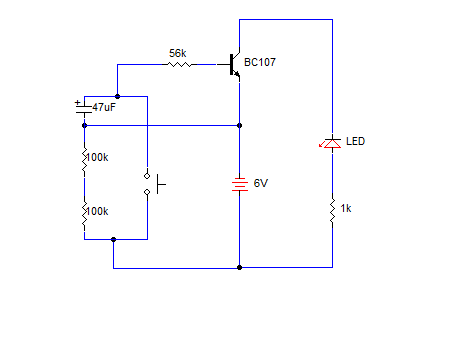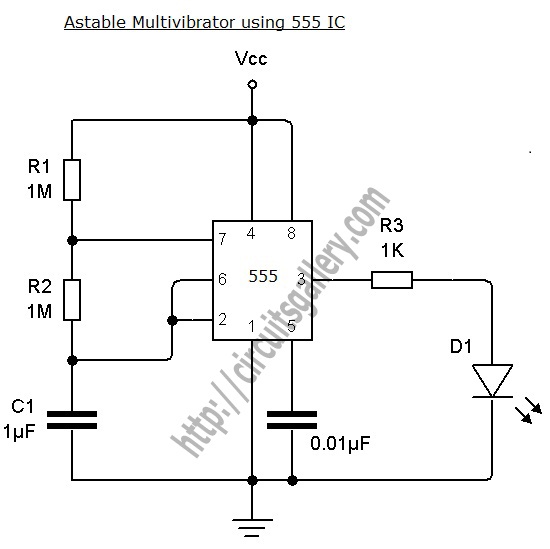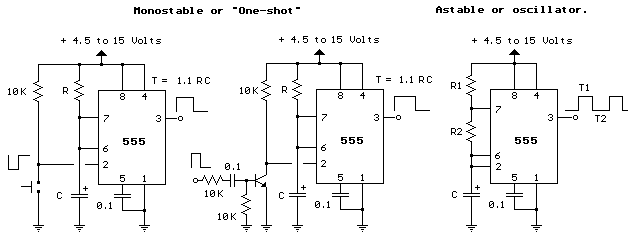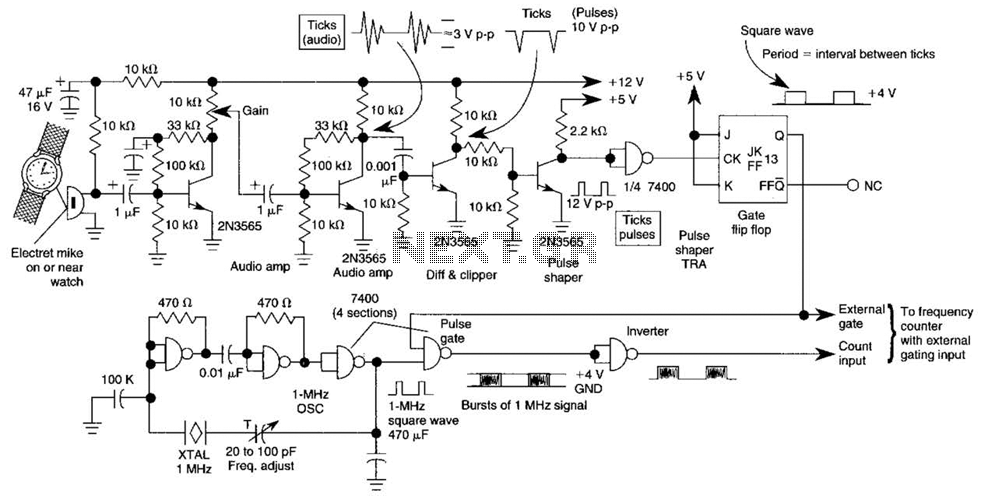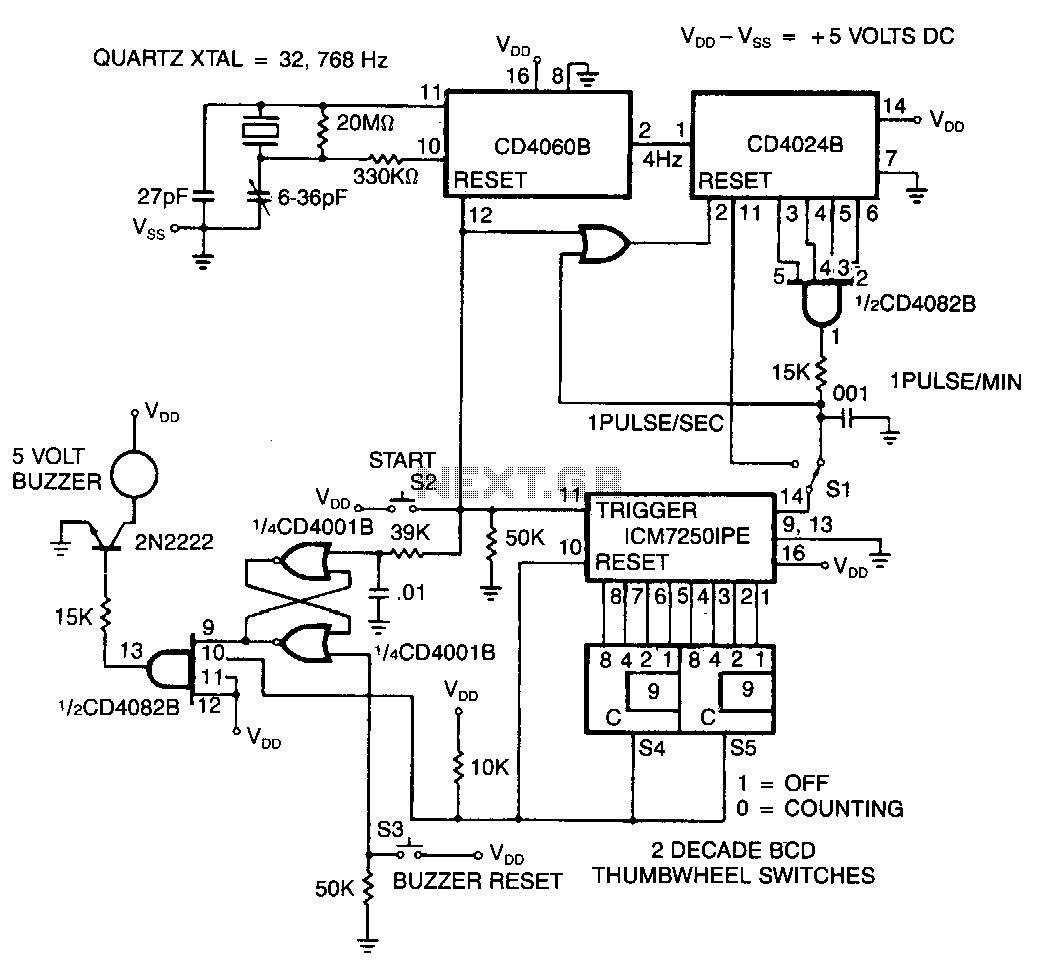
Periodic Timer Timing
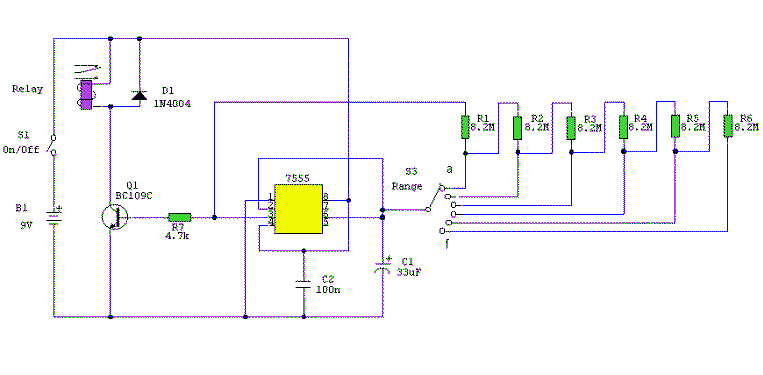
This timer circuit is similar to the 5 to 30 minute timer, but when switch S1 is closed, the on/off action of the circuit continues indefinitely until S1 is opened again. A 7555 timer and a low leakage capacitor for C1 must be used. The 6-way rotary switch S3 adds extra resistance in series to the timing chain with each rotation, with the minimum resistance at point "a" and the maximum at point "f." The 7555 is configured as an equal mark/space ratio oscillator, with the timing resistor chain R1 to R6 connected back to the output of the timer at pin 3. The output pulse duration is defined as follows: This results in on and off times of approximately 379 seconds for position "a" of S3 (just over 6 minutes) and about 38 minutes at point "f." The timing durations can be adjusted by changing R1 to R6 or C1.
The timer circuit described utilizes a 7555 timer IC, which is a versatile component known for its reliability in timing applications. The configuration allows for continuous operation once activated by switch S1, making it suitable for applications requiring prolonged timing without manual intervention. The use of a low leakage capacitor for C1 is crucial, as it ensures minimal current loss, thereby enhancing the accuracy and stability of the timing intervals.
The 6-way rotary switch S3 serves as a means to adjust the timing duration by varying the resistance in series with the timing circuit. Each position of the rotary switch introduces a different resistance value, effectively altering the charge and discharge time of the capacitor C1. At the minimum resistance setting (point "a"), the circuit is designed to achieve a pulse duration of approximately 379 seconds, translating to just over 6 minutes. Conversely, at the maximum resistance setting (point "f"), the output pulse duration can extend to around 38 minutes.
The timing resistor chain, composed of resistors R1 through R6, plays a critical role in determining the overall timing characteristics. By selecting appropriate resistor values, the user can fine-tune the timing intervals to meet specific application requirements. Additionally, the output pulse at pin 3 of the 7555 timer can be utilized to drive various loads or trigger other circuits, making this timer versatile for different electronic applications.
Overall, this timer circuit design is effective for applications requiring long-duration timing with the flexibility to adjust timing intervals easily through the rotary switch. The combination of the 7555 timer and the adjustable resistor network allows for a broad range of timing capabilities, making it a valuable addition to any electronics project requiring precise timing control.This timer circuit is similar to the 5 to 30 minute timer except that when switch S1 is closed, the on/off action of the circuit will continue indefinitely until S1 is opened again. A 7555 time and low leakage type capacitor for C1 must be used. The 6 way rotary switch S3 adds extra resistance in series to the timing chain with each rotation, mini
mum resistance point "a" maximum point "f". The 7555 is wired as an equal mark/space ratio oscillator, the timing resistor chain R1 to R6, being connected back to the output of the timer at pin 3. The output pulse duration is defined as:- This gives on and off times of about 379 seconds for position "a" of S3 (just over 6 minutes), to about 38 minutes at point "f".
The times may of course be varied by altering R1 to R6 or C1. 🔗 External reference
The timer circuit described utilizes a 7555 timer IC, which is a versatile component known for its reliability in timing applications. The configuration allows for continuous operation once activated by switch S1, making it suitable for applications requiring prolonged timing without manual intervention. The use of a low leakage capacitor for C1 is crucial, as it ensures minimal current loss, thereby enhancing the accuracy and stability of the timing intervals.
The 6-way rotary switch S3 serves as a means to adjust the timing duration by varying the resistance in series with the timing circuit. Each position of the rotary switch introduces a different resistance value, effectively altering the charge and discharge time of the capacitor C1. At the minimum resistance setting (point "a"), the circuit is designed to achieve a pulse duration of approximately 379 seconds, translating to just over 6 minutes. Conversely, at the maximum resistance setting (point "f"), the output pulse duration can extend to around 38 minutes.
The timing resistor chain, composed of resistors R1 through R6, plays a critical role in determining the overall timing characteristics. By selecting appropriate resistor values, the user can fine-tune the timing intervals to meet specific application requirements. Additionally, the output pulse at pin 3 of the 7555 timer can be utilized to drive various loads or trigger other circuits, making this timer versatile for different electronic applications.
Overall, this timer circuit design is effective for applications requiring long-duration timing with the flexibility to adjust timing intervals easily through the rotary switch. The combination of the 7555 timer and the adjustable resistor network allows for a broad range of timing capabilities, making it a valuable addition to any electronics project requiring precise timing control.This timer circuit is similar to the 5 to 30 minute timer except that when switch S1 is closed, the on/off action of the circuit will continue indefinitely until S1 is opened again. A 7555 time and low leakage type capacitor for C1 must be used. The 6 way rotary switch S3 adds extra resistance in series to the timing chain with each rotation, mini
mum resistance point "a" maximum point "f". The 7555 is wired as an equal mark/space ratio oscillator, the timing resistor chain R1 to R6, being connected back to the output of the timer at pin 3. The output pulse duration is defined as:- This gives on and off times of about 379 seconds for position "a" of S3 (just over 6 minutes), to about 38 minutes at point "f".
The times may of course be varied by altering R1 to R6 or C1. 🔗 External reference
